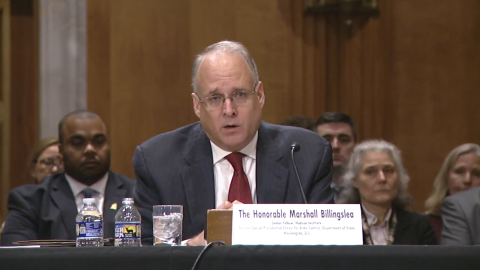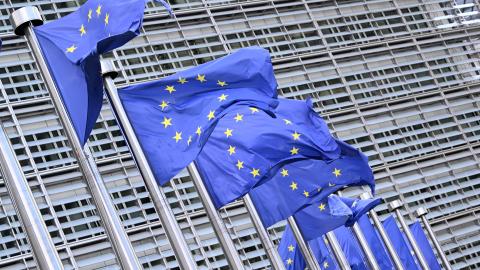This report was partially underwritten by a grant from Baron Public Affairs. In addition, the author acknowledges helpful comments from the Office of Advocacy of the Small Business Administration and its Chief Counsel for Advocacy Dr. Casey Mulligan. The SBA comments reflect concerns from small businesses regarding EU laws and regulations that create challenges for American small businesses. The conclusions, and any mistakes, in this report are entirely those of the author and should not be attributed to anyone else.
Introduction and Executive Summary
The European Union (EU) has recently adopted two legal frameworks: the Corporate Sustainability Reporting Directive (CSRD), which requires covered companies to publish reports on corporate social and environment plans and risks;1 and the Corporate Sustainability Due Diligence Directive (CS3D), which require covered companies to plan and to report in detail how they will meet certain environmental and human rights goals.2 Implemented over the next few years, these directives cover the following: human rights and the environmental rights; corporate conduct and structure; the transfer of substantial corporate control to “stakeholders”; the expansion of corporate liability; the expansion of damages for corporate shortcomings under the directives; and a vast array of reporting requirements.
Following 99 paragraphs of policy statements, including more than a dozen references to the United Nations, CS3D authorizes EU regulations related to human rights and the environment with few if any tangible limits.3 CS3D specifically aims to meet the Paris Agreement, to which the United States is not a participant.4 The potential EU regulations under these directives are summarized elsewhere.5 Other than small measurements of the costs of reporting and audit requirements,6 the EU does not appear to have conducted a comprehensive measurement of all the costs of the directives.
CSRD and CS3D are taxes on businesses operating in the EU. I begin by examining the effect on all American businesses operating in the EU, and I will then more narrowly focus on just those businesses that fall within the scope of the new regulations.
The EU’s CSRD and CS3D directives will limit the range of business activities for many firms, including many American firms. The overall effect of the regulations will be to increase the cost of production and economic activity in the EU and elsewhere. Those costs and those limitations on economic activity will be felt not only in the EU but also in other countries, including the United States, in the form of higher cost of living and lower economic opportunities.
Much of the cost of the directives will fall outside of the EU, and particularly in the United States. In response to Senate questions for the record prior to his confirmation, Commerce Secretary Howard Lutnick stated, “The CS3D imposes a significant burden on American corporations. I will consider using all available trade tools at the department’s disposal, as appropriate, to respond to any actions by foreign governments, including the EU, that harm the American economy and impose unreasonable burdens on our companies.”7 Other countries likely have a similar view of the EU’s imposition of substantial costs on their citizens through CS3D. If each country, including the United States, resorts to trade tools such as tariffs, the result would be a global trade war with substantial harm to American consumers.
How much will CSRD and CS3D initiatives harm American businesses and American consumers? Before this report, the question has remained unanswered.
CSRD and CS3D will likely cost America more than $1 trillion in measurable costs, and quite likely much more in immeasurable costs. I have not attempted to measure the costs of CSRD and CS3D on the European Union and European consumers. No doubt, those costs are substantial. It is possible that some of the costs on American businesses will be borne by European businesses and European consumers in the form of higher costs, lower quality services, and a reduced range of available products and services. But most, if not all, of the costs reported in this report are the direct costs to American businesses. I have not attempted to measure the substantial loss in consumer welfare, both in the United States and abroad through higher prices, lower quality of products and services, and a reduced range of available products and services.
CS3D is a tax on access to the EU market. At first glance, an American business could avoid the costs of CS3D by simply shunning the EU market. But, much as the EU’s General Data Protection Regulation (GDPR) has resulted in compliance from American businesses far removed from the EU market, so too CS3D will likely result in compliance by American firms far removed from the EU market. CS3D ultimately will require many parts of supply chains, including firms that do not directly sell in the EU, to have documentation that the firm complies with CS3D.
Most Americans have never heard of CSRD and CS3D, much less recognize the enormous threat they pose to the American economy. Yet CSRD and CS3D threaten greater costs to the American economy than practically any other set of regulations.
Baron Public Affairs asked the author to estimate the total costs of these initiatives on the United States, looking at the versions of CSRD and CS3D that are in force as EU laws at the time of writing (September 2025). This report estimates some, but not all, of the costs of CSRD and CS3D. Reliable estimates of many costs associated with these laws were not readily available at the time of writing.
Exhibit 1 summarizes the results of the report. The values in exhibit 1 reflect the order of magnitude of costs, in trillions of dollars, for American firms. Measurable one-time costs of implementation of supply chain compliance for CS3D are nearly $1 trillion or more. Measurable annual recurring costs of implementation for CSRD are in the tens or hundreds of billions of dollars. The net present value of those recurring costs for CSRD would then be in the hundreds of billions, or even trillions of dollars. Of course, the annual recurring costs for CS3D are likely to be substantially greater than the annual recurring costs for CSRD. Altogether, the measurable costs of CSRD and CS3D are easily in the trillions of dollars.
Exhibit 1: Summary of Costs of CSRD and CS3D for American Firms (in Orders of Magnitude of Trillions of Dollars)
|
Item |
Value (trillions) |
|---|---|
|
One-time measurable costs of implementation of bringing supply chain into compliance with CS3D |
1 |
|
Measurable annual recurring costs of CSRD compliance |
0.01–0.1 |
|
Net present value of annual recurring costs of CSRD compliance |
0.1–1 |
|
Immeasurable costs |
? |
The measurable costs under CS3D are likely small compared to immeasurable costs, such as the reduction in corporate control, the change in liability rules, and the uninsurable nature of the risks posed by the regulations. Under CS3D American corporations will lose substantial control to ubiquitous “stakeholders” and constant requirements for “due diligence” consultations. The costs of the loss of corporate control are unknown and unknowable.8 The costs of implementing the Paris Climate Accords, meeting other environmental goals, and accurately reporting the compliance of an American company with the EU objectives under American securities law will be daunting for all American companies, but particularly American public companies. No insurance is available for any of these costs. The immeasurable costs are likely more problematic than the measurable costs.
The costs of these regulations are in the trillions of dollars. These are among the most costly, if not the most costly, sets of regulations facing American businesses and consumers. Some, but likely not all, of the direct costs to businesses will be passed along to consumers. The indirect costs will be firms going out of business, reducing employment, and becoming unwilling to invest amid a hostile business climate. Small businesses are particularly vulnerable. The analysis below is organized as follows:
- Many American firms will be subject to CSRD and CS3D;
- The measurable costs of implementing CSRD and CS3D are quite likely in the trillions of dollars over two years;9
- The measurable annual recurring costs of CSRD and CS3D are in the tens or even hundreds of billions of dollars;
- The costs of noncompliance and civil liability are large; and
- The immeasurable costs of CSRD and CS3D are pervasive, likely higher than the measurable costs, and will harm American businesses.
Many American firms will be subject to CSRD and CS3D.
The reporting and audit requirements of CSRD are expected to apply to more than 50,000 firms, including thousands of American firms.10 CS3D, which has higher revenue requirements and more invasive regulations for due diligence and consultation with stakeholders, and which plans to meet certain environmental targets, will apply to fewer firms. The EU estimates that approximately 900 non-EU companies would be affected,11 no doubt several hundred of which would be US companies.
Exact lists of affected American firms under either regulation are not available for several reasons, including the following:
- The deadlines for reporting by US firms have not occurred;
- Some of the detailed threshold requirements for reporting are still in flux; and
- Many of the affected companies under CSRD are privately held and thus not required to disclose in advance their coverage.
One list of affected American companies has been assembled by the Centre for Research on Multinational Corporations (SOMO) and is available in their CSDDD Datahub.12 Some of the analysis below uses that list as a reference.
1. Three sets of firms for analysis
To estimate the costs of CSRD and CS3D to American firms, below is an examination of three sets of firms and their revenues:
- 50 percent of revenues of most vulnerable US industry sectors. Exhibit 2 presents a list of all American private businesses by industrial sector. It is my understanding that five sectors are the most vulnerable to CSRD and CS3D: agriculture and fisheries, mining, manufacturing, information, and finance.13 These sectors employ more than 24 million workers and have revenues in excess of $20 trillion. If 50 percent of these revenues of these sectors are at risk of the EU regulations, that would account for slightly more than $10 trillion. This measure is primarily on revenue in the United States, not global revenue, and this measure includes American subsidiaries of EU companies.
- The SOMO Fortune 500 list. The CSDDD Datahub identifies 172 firms from the Fortune 500 list that unambiguously qualify for CS3D.14 These firms had a combined global revenue of $9.931 trillion in 2024. But they firms are only a subset of the US firms known to be covered corporations under CS3D.
- S&P 500. The S&P 500 is a standard measure of the largest US corporations. Presumably, nearly all these firms would be subject to reporting requirements under CSRD, and many of these firms would be covered by CS3D as well. In 2024, these corporations had global revenues of nearly $17.5 trillion.
Exhibit 2: US Industry by Sector Most at Risk from EU Rules
|
Code |
Sector Title |
2022 number of US Entities |
2023 revenue (in billions of dollars) |
2022 number of US Entities most at risk |
2023 revenue of sectors most at risk (in billions of dollars) |
|
11 |
Agriculture, Forestry, Fishing, and Hunting |
367,959 |
622 |
367,959 |
622 |
|
21 |
Mining |
33,339 |
720 |
33,339 |
720 |
|
22 |
Utilities |
52,270 |
640 |
||
|
23 |
Construction |
1,512,763 |
2,336 |
||
|
31–33 |
Manufacturing |
660,640 |
7,211 |
660,640 |
7,211 |
|
42 |
Wholesale Trade |
698,477 |
2,841 |
||
|
44–45 |
Retail Trade |
1,870,617 |
2,773 |
||
|
48–49 |
Transportation and Warehousing |
711,582 |
1,751 |
||
|
51 |
Information |
370,463 |
2,517 |
370,463 |
2,517 |
|
52 |
Finance and Insurance |
771,419 |
9,337 |
771,419 |
9,337 |
|
53 |
Real Estate Rental and Leasing |
926,476 |
5,553 |
||
|
54 |
Professional, Scientific, and Technical Services |
2,489,746 |
5,577 |
||
|
55 |
Management of Companies and Enterprises |
93,116 |
784 |
||
|
56 |
Administrative and Support and Waste Services |
1,553,879 |
1,493 |
||
|
61 |
Educational Services |
430,343 |
3,761 |
||
|
62 |
Health Care and Social Assistance |
1,695,931 |
3,288 |
||
|
71 |
Arts, Entertainment, and Recreation |
385,880 |
2,189 |
||
|
72 |
Accommodation and Food Services |
931,927 |
1,671 |
||
|
81 |
Other Services (Except Public Administration) |
1,955,493 |
1,017 |
||
|
92 |
Public Administration |
256,211 |
5,097 |
||
|
Total |
17,768,531 |
61,175 |
2,203,820 |
20,406 |
|
|
Private industry |
17,512,320 |
56,077 |
2,203,820 |
20,406 |
|
Sources: Bureau of Labor Statistics, data for employment by major industry sector, table 2.1, accessed September 2025, https://www.bls.gov/emp/tables/employment-by-major-industry-sector.htm; for number of entities, see North American Industry Classification System, data for number of US entities, accessed September 2025, https://www.naics.com/search/; for revenues, see Bureau of Economic Analysis, industry economic accounts data, https://apps.bea.gov/iTable/?reqid=1603&step=2&Categories=GDPxInd&isURI=1.
Exhibit 3 summarizes these three measures for American firms possibly affected by CSRD and CS3D. For each measure, the value of revenues is in the many trillions of dollars. The number of affected firms, however, varies substantially from 172 to 500 to countless thousands.
Exhibit 3: Revenues Potentially at Risk (in Billions of Dollars)
|
50% of industry most at risk |
American companies from Fortune 500 that appear to qualify for CS3D |
Revenue of S&P 500 |
|---|---|---|
|
10,203 |
9,931 |
17,491 |
Sources: For most at risk, see exhibit 1; for Fortune 500, see David Ollivier de Leth, “CSDDD Datahub,” Centre for Research on Multinational Corporations (SOMO), accessed September 2025, https://www.somo.nl/csddd-datahub; for S&P 500, see Guru Focus, data for S&P 500 revenue as of June 30, 2025, https://www.gurufocus.com/economic_indicators/5748/sp-500-revenue-ttm.
2. Small businesses are vulnerable to CSRD and CS3D
The second and third of these measures focus on large corporations. The vulnerable industry measure includes many small businesses, but many small businesses outside of these sectors are likely vulnerable as well. This is not to say that American small businesses are immune to the costs and harms of CSRD and CS3D. To the contrary, they are perhaps the most vulnerable.
EU regulations such as CSRD and CS3D ultimately have no effective limitation on the size of companies that will ultimately comply. In economically integrated markets, all firms even remotely involved in EU commerce will comply. A similar example is the EU’s GDPR privacy rules. Many if not most American businesses now have GDPR-inspired consent forms on their homepages asking users to consent to the use of their information. American accounting and audit firms will likely develop forms seeking information about clients’ compliance with CSRD and CS3D. Any firm actually—or potentially—selling products or services directly or indirectly into the EU will likely need documentation proving compliance. The directives’ current proposed limitations to firms meeting certain revenue criteria will easily be modified over time, likely in the direction of moving more, not fewer, corporations under coverage.
Moreover, small businesses generally do not have the organizational structure and experience to address new and challenging regulations. For large corporations, addressing new regulations is often just a cost of doing business. For small businesses, these new regulations may pose an existential threat.
The measurable costs of implementing CSRD and CS3D are quite likely in the trillions of dollars over two years.
1. One-time costs of preparing for compliance
Most American firms, unlike European firms, are not focused on coming into compliance with the reporting requirements of EU directives like CSRD and CS3D. Some estimates of the costs of setting up a reporting system for CSRD are available and are presented in Exhibit 3. The European Financial Reporting Advisory Group (EFRAG), consultants retained by the EU, estimated in 2022 that setting up the reporting system would cost between 0.007 and 0.014 percent of corporate revenue. Exhibit 4 shows the percentage factors to the three different measures of affected American businesses. The cost of setting up CSRD reporting ranges from:
- $700 million, based on the low EFRAG estimate of 0.007 percent of revenue applied to American companies that appear to be first covered by CS3D, to
- $175 billion, based on the Ecobio estimate of revenue applied to the S&P 500.
The CSRD reporting requirements are much less demanding and costly than the reporting requirements for CS3D. The author was unable to find an estimate of the differences in the costs of the reporting requirements. But it is likely that the reporting costs for CS3D are substantially greater than for CSRD.
Exhibit 4: One-Time Setting Up Costs for CSRD Reporting for US Firms (in Billions of Dollars)
|
Source |
Percentage of revenue |
50% of industry most at risk |
American companies that appear to qualify for CS3D |
Revenue of S&P 500 |
||
|---|---|---|---|---|---|---|
|
EFRAG |
0.007% |
$0.71 |
$0.70 |
$1.22 |
||
|
EFRAG |
0.014% |
$1.43 |
$1.39 |
$2.45 |
||
|
Ecobio |
0.50% |
$51.02 |
$49.66 |
$87.46 |
||
|
Ecobio |
1% |
$102.03 |
$99.31 |
$174.91 |
||
Sources: Draft European Sustainability Reporting Standards (EFRAG, November 2022), 28, https://www.efrag.org/sites/default/files/sites/webpublishing/SiteAssets/05%20EFRAGs%20Cover%20Letter%20on%20the%20Cost-benefit%20analysis.pdf; “The Costs and Benefits of CSRD Reporting,” Ecobio, accessed September 2025, https://ecobiomanager.com/the-costs-and-benefits-of-csrd-reporting/.
2. Measurable costs to bring companies into compliance with CS3D regulations for supply chains
CS3D puts substantial reporting requirements on included corporations. But the legislation also threatens to force these firms to make substantial changes to their supply chains for regulatory compliance. The law firm DWF surveyed 1,200 C-suite executives in EU countries in 2024.15 Among other questions, DWF asked these executives to estimate the cost to bring their company’s supply chains into regulatory compliance. The survey found that “on average, C-suite leaders estimate that 9 percent of their revenue will be required to achieve a fully CS3D compliant value chain in the next two years.”16
A concrete example would be an American manufacturing company that must become compliant with CS3D in two years. The American firm would need a credible plan for itself, and for all of its suppliers, to meet all of the nearly 100 provisions of CS3D, including compliance with the Paris Climate Accord and various human rights provisions. To come into compliance, the American manufacturing company might be required to change its product mix, drop products, change many of its suppliers, and require its remaining suppliers to come into compliance with CS3D.
Exhibit 5 presents the estimated cost to bring different samples of firms into compliance with supply chain regulations under CS3D. DWF’s estimate of 9 percent of revenue results in costs from $894 billion to $1.574 trillion over two years.
The implementation costs in exhibits 4 and 5 could be combined. But the costs in exhibit 5 associated with bringing supply chains into compliance overwhelm the reporting costs implementation in Exhibit 4. Implementing EU regulations for CS3D is a roughly trillion-dollar enterprise for American businesses.
To put these costs estimates in some context, one estimate put the annual costs of all American federal regulations at $3.079 trillion in 2022.17 Even omitting all other costs of CS3D, the cost to bring supply chains into compliance with CS3D would account for a large portion of annual federal regulatory costs.
Exhibit 5: Estimated Costs to Bring Supply Chains into Compliance with CS3D Within Two Years (in Billions of Dollars)
|
50% of industry most at risk |
American companies that appear to qualify for CS3D |
Revenue of S&P 500 |
|---|---|---|
|
$918.29 |
$893.79 |
$1,574.19 |
Source: True Diligence (DWF Group, December 2024), https://dwfgroup.com/en/news-and-insights/reports-and-publications/true-diligence.
The measurable annual recurring costs of CSRD and CS3D are in the tens or even hundreds of billions of dollars.
1. Recurring costs of reporting compliance
Once a firm has set up its reporting system to comply with CSRD, it will incur annual recurring costs to report under CSRD. EFRAG estimates that these annual recurring costs are between 0.008 and 0.015 percent of revenue. Karl Burkhart estimates that these annual recurring costs for 10,000 non-European firms are $13.5 billion.18 This paper’s analysis assumes 30 percent of the non-European covered firms are American, resulting in slightly more than $4 billion in recurring costs.
Exhibit 6 displays the estimated range of annual recurring costs for CSRD. Of course, the recurring costs of CSRD are substantially less than the recurring costs of CS3D. The author has not found a reliable estimate of the recurring costs of CS3D, but they are almost certainly substantially greater than for CSRD. The EFRAG estimates range from a low value of $790 million under the low EFRAG rate applied to the 172 American companies that appear to be covered by CS3D to a high value of slightly more than $4 billion for the Karl Burkhart estimate.
Exhibit 6: Recurring Costs for CSRD Reporting for US Firms (in Billions of Dollars)
|
Source |
Percentage of revenue |
50% of industry most at risk |
American companies that appear to qualify for CS3D |
Revenue of S&P 500 |
|---|---|---|---|---|
|
EFRAG |
0.008% |
$0.82 |
$0.79 |
$1.40 |
|
EFRAG |
0.015% |
$1.53 |
$1.49 |
$2.62 |
|
Karl Burkhart |
— |
$4.04 |
— |
— |
Sources: For EFRAG, see Draft European Sustainability Reporting Standards; for Karl Burkhart, see Karl Burkhart, “How Much Will It Cost Companies to Comply with EU’s Nature Reporting Standard (ESRS)?,” Medium, July 9, 2025, https://medium.com/oneearth/how-much-will-it-cost-companies-to-comply-with-eus-nature-reporting-standard-esrs-90b5d46dd86e.
Note: This assumes $8 billion for auditing and that US firms represent 30 percent of 10,000 non-EU firms.
2. Recurring costs for auditing compliance
Both CSRD and CS3D have substantial auditing requirements. EFRAG estimated auditing costs just for CSRD under two scenarios: a “limited assurance” condition and a “reasonable assurance” condition. Limited assurance, “implies a reduction in assurance engagement risk to a level that is acceptable in the circumstances of the engagement.”19 Reasonable assurance is a much higher level of assurance that will be applied in later years at more than twice the cost of limited assurance.20
Exhibit 7 presents estimates of annual assurance costs to US firms for both limited assurance and reasonable assurance under CSRD. The limited assurance cost ranges from $40 million at the low range when the low EFRAG cost rate is applied to the 172 companies in the covered list. The cost reaches $4.55 billion when the EFRAG high-cost rate is applied to the S&P 500. The reasonable assurance cost ranges from $90 million at the low range when the low EFRAG cost rate is applied to the 172 companies. It reaches $11.19 billion when the EFRAG high-cost rate is applied to the S&P 500. The Karl Burkhart annual cost estimate for auditing for US firms under CSRD is $870 million.
Of course, CS3D presents substantially greater audit requirements than CSRD. The author has not found estimates of CS3D’s audit costs, but they are substantially greater than the CSRD audit costs.
Exhibit 7: Recurring Auditing Costs for US Firms for CSRD (in Billions of Dollars)
|
Source |
Assurance |
Percentage of revenue |
50% of industry most at risk |
American companies that appear to qualify for CS3D |
Revenue of S&P 500 |
|---|---|---|---|---|---|
|
EFRAG |
Limited assurance |
0.0004% |
$0.04 |
$0.04 |
$0.07 |
|
EFRAG |
Limited assurance |
0.026% |
$2.65 |
$2.58 |
$4.55 |
|
EFRAG |
Reasonable assurance |
0.0009% |
$0.09 |
$0.09 |
$0.16 |
|
EFRAG |
Reasonable assurance |
0.0640% |
$6.53 |
$6.36 |
$11.19 |
|
Karl Burkhart |
— |
— |
$0.87 |
— |
— |
Sources: For EFRAG, see Draft European Sustainability Reporting Standards; for Burkhart, see “How Much Will It Cost Companies to Comply with EU’s Nature Reporting Standard (ESRS)?”
3. Measurable annual costs of changing conduct
Exhibit 8 presents low and high cases for the total recurring costs of reporting and audits under CSRD from exhibits 6 and 7 in both a limited assurance and a reasonable assurance scenario. The lowest cost estimate is $830 million for limited assurance for the 172 companies in the covered sample. The highest cost is $13.82 billion for the S&P 500. This report uses these cost values to estimate the costs of changing conduct reported in the next section. The annual reporting costs and audit costs under CS3D are substantially higher.
Exhibit 8: Annual Recurring Reporting and Auditing Costs under CSRD (in Billions of Dollars)
|
Source |
Assurance |
Scenario |
50% of industry most at risk |
American companies that appear to qualify for CS3D |
Revenue of S&P 500 |
|---|---|---|---|---|---|
|
EFRAG |
Limited assurance |
Low |
$0.86 |
$0.83 |
$1.47 |
|
EFRAG |
Limited assurance |
High |
$4.18 |
$4.07 |
$7.17 |
|
EFRAG |
Reasonable assurance |
Low |
$0.91 |
$0.88 |
$1.56 |
|
EFRAG |
Reasonable assurance |
High |
$8.06 |
$7.85 |
$13.82 |
Sources: Exhibits 6 and 7 (combination of recurring reporting and auditing costs).
The EFRAG reports focus on reporting and audit costs for CSRD. Those are usually just the tip of the iceberg for environmental regulation. Firms will also face costs of changing corporate conduct, some of which are measurable and some of which are not. Measurable costs include pollution abatement and other direct compliance costs other than reporting and auditing.
Several studies include measures of the ratio of administrative costs to abatement and compliance costs. A study by Satish Joshi, Ranjani Krishnan, and Lester Lave finds that every dollar of visible spending on regulation reflects $10 of spending in less visible accounts. Exhibit 9 applies this ratio to the recurring costs for CSRD from exhibit 8 and estimates the annual measurable costs of change in conduct.21 Estimates range from $8.34 billion with the low-cost estimate for limited assurance applied to the 172 firms in the covered sample, to $138.18 billion for the high cost of reasonable assurance for the S&P 500. If estimates of recurring costs were available for CS3D, the costs estimates in exhibit 9 would be correspondingly higher.
Exhibit 9: Implicit Change in Measurable Annual Conduct Costs (in Billions of Dollars)
|
Source |
Scenario |
50% of industry most at risk |
American companies that appear to qualify for CS3D |
Revenue of S&P 500 |
|---|---|---|---|---|
|
EFRAG (limited assurance) |
Low |
$8.57 |
$8.34 |
$14.69 |
|
EFRAG (limited assurance) |
High |
$41.83 |
$40.72 |
$71.71 |
|
EFRAG (reasonable assurance) |
Low |
$9.08 |
$8.84 |
$15.57 |
|
EFRAG (reasonable assurance) |
High |
$80.61 |
$78.45 |
$138.18 |
Source: Satish Joshi, Ranjani Krishnan, and Lester Lave, “Estimating the Hidden Costs of Environmental Regulation,” Accounting Review 76, no. 2 (April 2001): 171–98, https://www.jstor.org/stable/3068911.
Pizer and Kopp examine various cost categories for pollution abatement.22 The average ratio of administrative costs to pollution abatement by businesses and consumers ranged from 4.9 percent to 5.7 percent over three years, and averaged 5.3 percent. Using that ratio, exhibit 10 estimates annual measurable costs of change in conduct. Estimates range from $15.74 billion with the low-cost estimate for limited assurance applied to the 172 firms in the covered sample, to $260.71 billion for the high cost of reasonable assurance for the S&P 500. If estimates of recurring costs were available for CS3D, the costs estimates in exhibit 10 would be correspondingly higher.
Exhibit 10: Implicit Measurable Annual Costs for Change in Conduct Costs (in Billions of Dollars)
|
Source |
Scenario |
50% of industry most at risk |
American companies that appear to qualify for CS3D |
Revenue of S&P 500 |
|---|---|---|---|---|
|
EFRAG (limited assurance) |
Low |
$16.17 |
$15.74 |
$27.72 |
|
EFRAG (limited assurance) |
High |
$78.93 |
$76.82 |
$135.31 |
|
EFRAG (reasonable assurance) |
Low |
$17.13 |
$16.68 |
$29.37 |
|
EFRAG (reasonable assurance) |
High |
$152.09 |
$148.03 |
$260.71 |
Source: William A. Pizer and Raymond Kopp, “Calculating the Costs of Environmental Regulation,” Resources for the Future, March 2003, https://media.rff.org/documents/RFF-DP-03-06.pdf.
In yet another study, Christine Volgan, using data from the Bureau of Economic Analysis, finds that administrative costs account for 1.8 percent of pollution abatement costs for 1.8 percent of pollution abatement control costs.23 With that ratio, exhibit 11 presents estimates of annual measurable costs of change in conduct. Estimates range from $46.34 billion with the low-cost estimate for limited assurance applied to the 172 firms in the covered sample, to $767.66 billion for the high cost of reasonable assurance for the S&P 500. If estimates of recurring costs were available for CS3D, the costs estimates in exhibit 11 would be correspondingly higher.
One can combine the measurable annual recurring costs for reporting and auditing in exhibit 8 (mostly in the billions of dollars) with the measurable annual recurring costs for mitigation in exhibits 9 to 11 to find that the total measurable annual recurring costs for CSRD and CS3D are in the tens or hundreds of billions of dollars.
Exhibit 11: Implicit Measurable Annual Costs for Change in Conduct Costs (in Billions of Dollars)
|
Source |
Scenario |
50% of industry most at risk |
American companies that appear to qualify for CS3D |
Revenue of S&P 500 |
|---|---|---|---|---|
|
EFRAG (limited assurance) |
Low |
$47.61 |
$46.34 |
$81.62 |
|
EFRAG (limited assurance) |
High |
$232.41 |
$226.21 |
$398.41 |
|
EFRAG (reasonable assurance) |
Low |
$50.45 |
$49.10 |
$86.48 |
|
EFRAG (reasonable assurance) |
High |
$447.81 |
$435.86 |
$767.66 |
Source: Christine R. Volgan, “Pollution Abatement and Control Expenditures,” Survey of Current Business, September 1996, chart 2, https://apps.bea.gov/scb/pdf/national/niparel/1996/0996eed.pdf.
The costs of noncompliance and civil liability are large.
The EU threatens that it can assess penalties of as much as 5 percent of global revenue for non-compliance with CS3D.24
Potentially more costly than the penalties for noncompliance is the imposition of civil liability for failure to comply with a wide range of provisions under CS3D. For example:
Member States shall ensure that a company can be held liable for damage caused to a natural or legal person, provided that:
(a) the company intentionally or negligently failed to comply with the obligations laid down in Articles 10 and 11, when the right, prohibition or obligation listed in the Annex to this Directive is aimed at protecting the natural or legal person; and
(b) as a result of the failure referred to in point (a), damage to the natural or legal person’s legal interests that are protected under national law was caused.25
Under CS3D, a company is at risk for both penalties and civil liability for noncompliance with a wide range of rules.
The immeasurable costs of CSRD and CS3D are pervasive and will harm American businesses.
While some of the costs of CSRD and CS3D are measurable, many if not most are not. Below are just a few examples of immeasurable costs of these regulations.
1. Dramatic change in market conditions.
CSRD and CS3D create major changes in market conditions. Some firms will simply go out of business. Others will be dramatically altered and exit certain lines of business. The measurable costs above are for the firms that remain in business and remain in the same lines of business, not for the many firms that will exit the market or dramatically change.
The measurable costs of the regulation described above are substantial and would almost certainly lead to substantial increases in prices for American consumers. The prices of various factors of production, particularly energy, metals, food, and materials that are transported long distances, are likely to increase as a result of the new CSRD and CS3D rules. These price increases would diminish the welfare of American consumers.
2. Dramatic change in corporate responsibilities and objectives
Most American businesses seek to make profits. They generally are not responsible as primary agents in implementing government objectives. CS3D changes that and makes corporations primary agents of government policy. For example, CS3D requires companies to take the following steps:
(1) integrating due diligence into policies and management systems; (2) identifying and assessing adverse human rights and environmental impacts; (3) preventing, ceasing or minimising actual and potential adverse human rights and environmental impacts; (4) monitoring and assessing the effectiveness of measures;(5) communicating; and (6) providing remediation.26
The very first article of the law, article 1, states the following (emphasis added):
This Directive lays down rules on:
(a) obligations for companies regarding actual and potential human rights adverse impacts and environmental adverse impacts, with respect to their own operations, the operations of their subsidiaries, and the operations carried out by their business partners in the chains of activities of those companies;
(b) liability for violations of the obligations as referred to in point (a); and (c) the obligation for companies to adopt and put into effect a transition plan for climate change mitigation which aims to ensure, through best efforts, compatibility of the business model and of the strategy of the company with the transition to a sustainable economy and with the limiting of global warming to 1,5° C in line with the Paris Agreement.27
3. Diminution of corporate control
Under American corporate law, only corporate owners and duly appointed corporate officers have control of the corporation and can make decisions on behalf of the company. Government agencies can, through laws and regulations, limit corporate conduct. Third parties can influence corporate conduct through contracts. Remarkably, CS3D shifts corporate control and decision-making away from the shareholders and management of the company towards governments and vaguely defined “stakeholders.” Stakeholders are mentioned 61 times and appear to be everyone in the world except corporate management and shareholders.28 Corporations appear to cede substantial control over the corporation to these ubiquitous stakeholders who must be consulted about practically all corporate decisions. For example, article 13 states:
Consultation of stakeholders shall take place at the following stages of the due diligence process:
(a) when gathering the necessary information on actual or potential adverse impacts, in order to identify, assess and prioritise adverse impacts pursuant to Articles 8 and 9; (b) when developing prevention and corrective action plans pursuant to Article 10 and Article 11, and developing enhanced prevention and corrective action plans pursuant to Article 10 and Article 11; (c) when deciding to terminate or suspend a business relationship pursuant to Article 10 and Article 11; (d) when adopting appropriate measures to remediate adverse impacts pursuant to Article 12; (e) as appropriate, when developing qualitative and quantitative indicators for the monitoring required under Article 15.
Simply stated, an American corporation under CS3D must consult with stakeholders at many, if not all, important corporate decisions. No doubt, failure to implement the stakeholder consultation process in article 15 could lead to corporate liability in disputes with stakeholders. Meaningful control of the corporation is lost.
Troubling also is the emphasis on “due diligence” in the stakeholder consultation process. As mentioned above, due diligence is mentioned 138 times in the 58-page directive, and at each instance of due diligence, the stakeholder consultation process of article 13 could, and likely would, be invoked. The corporation, rather than running an efficient business, is required to engage in more than 100 forms of due diligence and consult with an exhaustive list of stakeholders in each of these instances.
American companies, and international firms operating in the United States, are not immune to the regulations under CSRD and CS3D. Those directives transfer corporate control to EU governments and stakeholders not only on corporate conduct in the EU but for corporate conduct in other countries including the United States.
The author has found no discussion, much less cost estimates, of the dramatic shift in corporate control under CSRD and CS3D. Those effects are large but currently unmeasured.
4. Changes in business liability
CS3D is not merely about shifting corporate control but also about liability, particularly civil liability, to corporations under the directive. Civil liability, damages, and remediation are frequently mentioned in CS3D.29 Not only does it assign liability to corporations, it also frequently requires damages and remediation. CSRD and CS3D are dramatic changes of law not only for corporate control but for liability and damages as well.
Independent of the formal EU governmental enforcement of the rules, American corporations are vulnerable to shareholder lawsuits for failure to disclose relevant information that might affect the value of securities. CSRD and CS3D create seemingly unbounded obligations to engage in vaguely specified forms of due diligence and to consult with countless so-called stakeholders. Each of these activities is potentially a reportable event. Efforts to comply with the directives may reduce legal exposure to EU governmental oversight and penalties but may paradoxically create substantial legal liability in the United States.
The author has found no discussion, much less cost estimates, of the dramatic shift in corporate liability under CSDR and CS3D directives. Those effects are large but currently unmeasured.
5. The EU Initiatives have uninsurable risks that add to the costs of regulation
Businesses can insure against various types of risk that are predictable and for which there are large samples of prior events from which to measure the risk. For at least the following reasons, the uncertainty surrounding the EU initiatives is not amenable to insurance:
- Final regulations are in flux.
- Even when final regulations are promulgated, the extent and the potential effects of the rules are practically unbounded. The extent of regulation is so vast that any cost estimate would be a rough approximation at best.
- Even if a precise estimate of the effect of the final rules were possible, the enforcement of those rules, particularly with respect to American firms or to any firms operating in the United States, is an unknowable risk.30 Moreover, it is an uninsurable risk.
- Even if enforcement were known with certainty, the EU can modify underlying rules—and enforcement policies—rapidly. In 2025 alone, the EU has modified the implementation rules and proposed additional amendments several times.31
6. Changes in the relative regulation of different industries
Not all industries will be identically affected. Some activities that are not specifically excluded, such as hydrocarbon extraction, may be substantially curtailed or even eliminated as a result of environmental regulatory objectives independent of costs. Some industries are more likely to be affected than others including manufacturing and distribution of textiles, leather goods, agriculture, forestry, fisheries, food and beverage manufacturing, and extractive industries.32American businesses in certain industries such as Internet-related businesses have been frequent targets of EU regulation in the past, and CSRD and CS3D regulations may provide new avenues for EU oversight of these companies.
Many reviews of CSRD and CS3D regulations focus on the distinction between the covered companies—large companies that will have substantial reporting requirements and face potential liability and penalties—and smaller companies that do not have the same reporting requirements or face direct liability. But the changes in business activity in the EU as a result of CSRD and CS3D regulations are likely to affect all American companies, large and small, operating in the EU.
7. Costs to American consumers
The greatest costs of CS3D will fall on American consumers. Consider the effects on consumers of a requirement that 50 percent of cars be electric—almost certainly a much lower target than would be required under CS3D, which requires compliance with the Paris Climate Accords. The Environmental Protection Agency recently released a study finding that the costs to American consumers of shifting to a 50 percent electric fleet “must exceed $100 billion annually and likely near $300 billion.”33 That would be the cost of a milder version of just one part of CS3D regulations on American consumers. The total costs to American consumers—in the form of higher prices, lower quality products and services, prevention from purchasing some goods and services altogether, and the loss of innovation—are immeasurable.



















